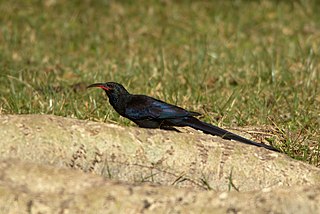
Hoopoes are colourful birds found across Africa, Asia, and Europe, notable for their distinctive "crown" of feathers. Three living and one extinct species are recognized, though for many years all of the extant species were lumped as a single species—Upupa epops. In fact, some taxonomists still consider all three species conspecific. Some authorities also keep the African and Eurasian hoopoe together but split the Madagascar hoopoe. The Eurasian hoopoe is common in its range and has a large population, so it is evaluated as Least Concern on The IUCN Red List of Threatened Species. However, their numbers are declining in Western Europe. Conversely, the hoopoe has been increasing in numbers at the tip of the South Sinai, Sharm el-Sheikh. There are dozens of nesting pairs that remain resident all year round.

Woodpeckers are part of the bird family Picidae, which also includes the piculets, wrynecks and sapsuckers. Members of this family are found worldwide, except for Australia, New Guinea, New Zealand, Madagascar and the extreme polar regions. Most species live in forests or woodland habitats, although a few species are known that live in treeless areas, such as rocky hillsides and deserts, and the Gila woodpecker specialises in exploiting cacti.

Coraciidae is a family of Old World birds, which are known as rollers because of the aerial acrobatics some of these birds perform during courtship or territorial flights. Rollers resemble crows in size and build, and share the colourful appearance of kingfishers and bee-eaters, blues and pinkish or cinnamon browns predominating. The two inner front toes are connected, but not the outer one.

The green wood hoopoe is a large, up to 44 cm (17 in) long tropical bird native to Africa. It is a member of the family Phoeniculidae, the wood hoopoes, and was formerly known as the red-billed wood hoopoe.

Bucerotiformes is an order of birds that contains the hornbills, ground hornbills, hoopoes and wood hoopoes. These birds were previously classified as members of Coraciiformes. The clade is distributed in Africa, Asia, Europe and Melanesia.

Scimitarbills are three species of African bird belonging to the genus Rhinopomastus. They are often classified in the woodhoopoe family, Phoeniculidae; however, genetic studies show that they diverged from the true woodhoopoes about 10 million years ago and so they are sometimes placed in a family of their own, the Rhinopomastidae.

The white-headed wood hoopoe is a species of bird in the family Phoeniculidae.

Phoeniculus is a genus of bird in the family Phoeniculidae. They are restricted to sub-Saharan Africa.

The black-billed wood hoopoe is a species of bird in the family Phoeniculidae. It is native to eastern Africa where it is found in wooded and scrubby areas.

The Abyssinian scimitarbill is a species of bird in the family Phoeniculidae. The term Abyssinia, is an old name for the region of Ethiopia, and scimitar refers to a curved sword, which its bill resembles. It is found in Djibouti, Ethiopia, Kenya, Somalia, South Sudan, Tanzania, and Uganda. The bird is non migratory, diurnal, and terrestrial. Their nests are sometimes parasitized by the greater honeyguide which are favored by some because they can guide to beehives.

Celeus is a genus of bird in the woodpecker family, Picidae, found in tropical and subtropical forests and woodlands of Central and South America. The genus contains 13 extant species. One, Kaempfer's woodpecker, was believed to be extinct until a specimen was caught in 2006.













